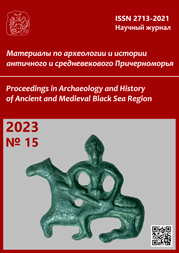Стрелы-джебе в ногайлинско-казахском героическом эпосе
Arrows-jebe and the Noghaic-Kazakh heroic epos
Author(s): O.M. Agatay, Zh.M. Sabitov, N.A. DossymbetovSubject(s): History, Cultural history, Customs / Folklore
Published by: Нижневартовский государственный университет
Keywords: arrows-jebe; the Turkic heroic epos; Tavarikh-i Guzida-i Nusrat-nama; nomadic warriors; the Great Steppe;
Summary/Abstract: The article amasses accounts from the Noghaic-Kazakh heroic epos which enable new insights in the variability of names and phrases describing ranged weapons (arrows-jebe). Formerly, these accounts have not yet been the scope of a focused scholarly study and were not even translated into foreign languages, including Russian. Now, when analyzing folklore, artifacts and written sources in detail, an attempt is made to identify the original names and constructive merits and decorative systems in jebe arrows of the Turkic warriors of the Great Steppe in the Middle Ages and the Modern Era. Using the research database from accumulated, systemized and analyzed records, basic terms and phrases were found and attributed in the Noghaic-Kazakh heroic epos denoting parts of ranged weapons, the arrows-jebe. It has been established that during the Middle Ages and the Modern Era, in Dast-i Qipčaq — the Crimean steppe, Lower Volga Region, West Kazakhstan, and Western Siberia — as well as in Aral—Syr Darya Region, Zhetysu, Altai, and elsewhere, the ranged weapons were used by the nomadic warriors, including oq (an arrow), jebe (a jebe- arrowhead), qasalaq (a qasalaq-arrow). A variety of the arrow-related terms and phrases includes sauīt būzar oq (an armor-piercing arrow), ajal oq (‘an arrow of death’), qozī jauīrīn oq (an arrow in the shape of a lamb’s scapula), salalī sausaq jebe (an arrow in the shape of two-forked fingers), aj oq (‘a moon-shaped’ arrow), masaq oq (a arrowhead), sajkez oq (a sajkez-arrow), ulī oq (a poisoned arrow), beren oq (a beren-arrow), sūr jebe (a grey jebe), kök jebe (a blue jebe), aq jebe (a white jebe), altī qīrlī jebe (a hexagonal jebe), segїz qīrlī jebe (an octagonal jebe), qīrīq kez oq (an arrow of forty yards), on ekї tūtam oq (an arrow of twelve fists), küşїgen jündї oq (an arrow with vulture’s feathers), qanattī oq (a winged arrow), etc. The matching of the epic descriptions of the arrows-jebe with various written records and genuine samples from archeological sites reveals a high level of correlation between folklore and narratives and artifacts. The focus on a comprehensive analysis of the accounts under study testifies that the Noghaic-Kazakh heroic epos is highly applicable to studying military-cultural heritage of the Turk and Mongol peoples of Eurasia during the Late Middle Ages and the Modern Era.
Journal: Материалы по археологии и истории античного и средневекового Причерноморья
- Issue Year: 2023
- Issue No: 15
- Page Range: 665-686
- Page Count: 22
- Language: Russian

